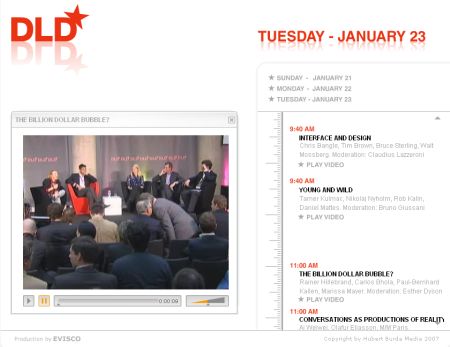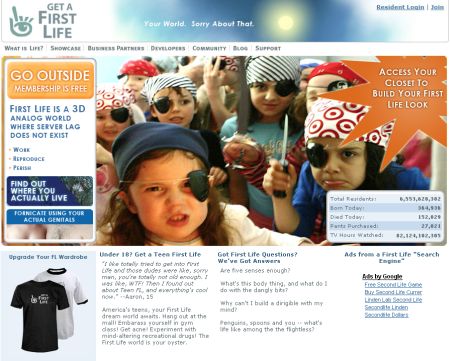von Roland Hachmann | Jan. 23, 2007 | Blog, Digital Culture, Digital Marketing
Ok, there goes the weekend. Guess I’ll be pretty busy – I just found out that you can watch all the videos of the “Digital Life Design†Day on the DLD 07 Media Website. See Marissa Mayer of Google speak about the billion dollar bubble or John Naisbitt about “Mind Set!â€, probably based on his new book. Or Luc Besson, Craig Newmark, David Sifry, Arianna Huffington. See? Guess you’ll be busy, too. 
von Roland Hachmann | Jan. 22, 2007 | Blog, Digital Culture, Social Media Marketing
Love it! Werbeblogger just pointed me to a cool siteGet a first life (go outside, membership is free).
And of course it lists total residents (6+ billion), you can get first life clothing for real dollars (at cafepress.com), in a 3D analog world, where server lag does not exist. Hhm, maybe I should try that sometime.
von Roland Hachmann | Jan. 20, 2007 | Blog, Digital Marketing, Digital News, Online Advertising
On the Church of the Customer Blog is an interesting Post about CBS Subscription figures on YouTube.
in the first three months of having CBS content on YouTube more than 40,000 people subscribed to the CBS channel. Plus, it had tallied 75 million total views of the 700+ CBS-uploaded videos.
They calculate out the possible (!) longer term figures resulting in more than 300 million pageviews and 160.000 subscribers. But the number of 160.000 is much more important and valueable than the number of pageviews.
Subscriber growth is really the new keystone measure of success because it’s the best indicator of your ability to create loyalty.
This is absolutely true. For some reason, we have forgotten about the bursting bubble a few years back and we have again started talking about millions of video and page views and downloads (and pageviews are no longer a strong currency).
But the true value of the new web2.0 platforms doesn’t reside in the reach of eyeballs itself, but in the stickiness factor of glueing these eyeballs to the site, day after day. Loyalty, in a word. And the possibility to extract complex profiles through user data and behaviour for targetting, as well as maximising the frequency of interaction by the user through this knowledge. Ever more important, since most web2.0 business models are relying on advertising for funding. (And it can’t all just be Google Adsense, I suppose.)
So, in order to avoid the web 1.0 bubble, you should ask the following questions when considering web2.0 business models.
- Will users come back frequently for new content? Easy in communities of user generated content, you should think, because the content changes all the time. But then: what is the start-page of the user for any given page? When I go to YouTube, it shows some of the latest videos, which makes it interesting everyday. Visiting Flickr, I see my own pictures&profile first and I have to click through a couple of menues in order to get to any new or interesting pictures. The first view of flickr is usually quite boring, even though the whole site is based on user generated content. So you need to consider if the page is actually suggesting added value right from the beginning.
- Can users easily be identified as unique users based on a registration? I suppose all web2.0-ish plattforms require the users to register in a more or less detailed way in order to publish content. However, not all websites make it easy to sign on, i.e. automatic sign on. Some platforms recognise you through a cookie, so that you don’t have to login, some don’t – so the user gets a generic start page. These users might spend a considerable amount of time on the site without registering and we will never be able to match their clickpaths to their profile.
- Will it be possible to profile these users on preferences? Speaking of visitors having to register, are we asking them for their preferences? Are we trying to find out, what they are interested in and what areas of interest they may talk to them about in the future? (In order to offer more targetted advertising, of course.)
- Will it be possible to profile these users based on behavioural data? And if they don’t register for certain topics, will we at least gain insights through behavioural data, measuring and tracking their paths through our website in order to find out, what they like? Would we even have it on top of the other data they gave us during registration (which would be best)?
Eyeballs are valuable, no doubt. But eyeballs that we know certain things about are even more valuable, especially if we can differentiate between the eyeballs of the top 20% and the other 80% – thinking about the Pareto principle. In future, those web 2.0 platforms will succeed, that can link the pure webstats to concrete user profiles that offer the possible insights of “qualified leads†to companies advertising on that site.
All of this is already possible, I think, but at the same time I get the feeling, that most web2.0 sites are still mostly interested in maximising eyeballs and (general) profiles – neglecting the deeper profiling opportunities that advertisers will soon ask for.
von Roland Hachmann | Jan. 19, 2007 | Blog, Digital Culture, Marketing
This is an excellent truffle: A Periodic Table of Visualization Methods. Excellent source of inspiration. Some visualisations are known, some are inspiring (at least to me). Here are the categories:
- Data visualisation
- Information visualisation
- concept visualisation
- strategy visualisation
- metaphor visualisation and
- compound visualisation
And the whole thing looks like this:
But you should really click through to the table (made in Flash) itself, because for each of the squares, the visualisation is shown as a popup.
von Roland Hachmann | Jan. 18, 2007 | Ad News, Blog
A new Face2Face Interview is online at Adcritic.com. This time (Part 2) it is with Jeff Goodby. (Part 1 was with Alex Bogusky)

![]()





 Wo ich sonst so bin...
Wo ich sonst so bin...